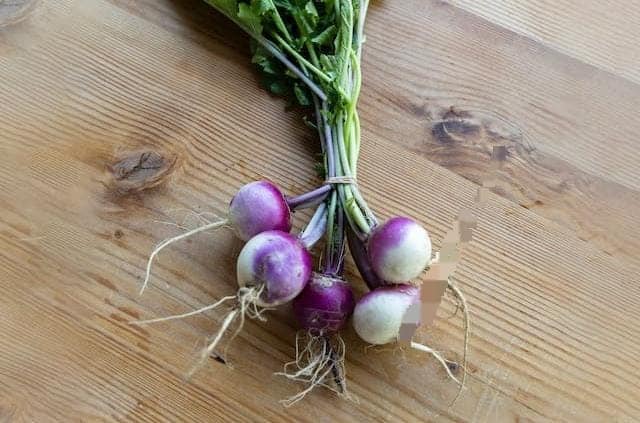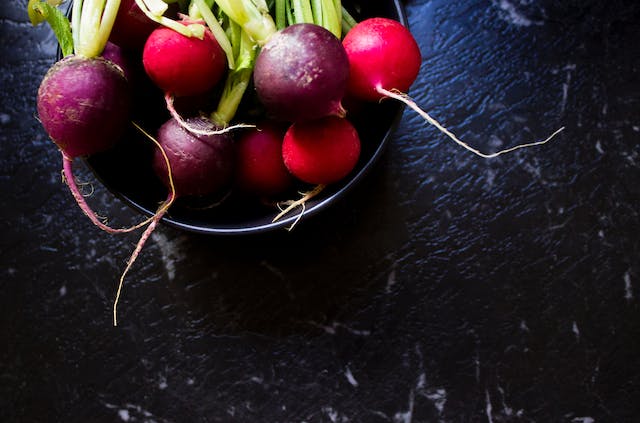What are the differences between a turnip vs a radish?
Turnips and radishes are cruciferous vegetables that belong to the Brassica family. Other cruciferous vegetables that belong to the Brassica family include cauliflower, cabbage, and broccoli.
Turnips are cruciferous vegetables with edible hairy leaves. They naturally come in a variety of colours like purple, yellow, and white.
Radish is a pungent crisp root and it can be eaten raw. Turnips and radishes contain healthy nutrients and compounds that fight off diseases.
These vegetables are useful in the production of cosmetic products and medicine. They are root vegetables with similar appearance but turnips and radishes are different plants.
What health benefits do these root vegetables have and what is the comparison in size?

What Is a Turnip?
Turnips are root vegetables that come from the Brassica family. It’s a widely cultivated plant with white, yellow, and purplish roots.
Turnips are root vegetables that are naturally found in countries with a temperate climate. This root vegetable comes in different varieties, but only small and tender types of turnips are consumed by humans.
It’s not just us who find turnips as an edible root to consume. Turnips are also given to animals to eat. Livestock consume a larger variety of turnips as food.
Also, there is a difference between a turnip and a rutabaga. People are sometimes confused about differentiating turnips from rutabaga. Turnips and rutabaga are from the Brassica family, but they are different plants.
The rutabaga is referred to as the swede, or Swedish turnip (the European plant Brassica napus). It’s considered to be a hybrid between a cabbage and a turnip.
Also Read: Wheelbarrel vs Wheelbarrow: Difference and Comparison
What Is a Radish?
Radishes are plants of the Brissicaceae family, Raphanus sativus, with edible roots. Radishes and turnips are edible root vegetables that contain healthy nutrients.
This root vegetable is often used to prepare meals. Yes, radishes can be mixed into salads and sandwiches to make tasty meals.
Naturally, radishes come in varieties, flavours, and sizes. They are edible root vegetables that you can’t put in a single category.
Radishes are root vegetables that can be used to make tasty meals. They produce a sharp flavour due to the chemical compounds produced by the plant.
The chemical compound produced by the plant includes glucosinolate, myrosinase, and isothiocyanate.
Radishes are plants that are easy to grow and quick to harvest. They can even be planted by novice gardeners. Radishes are also used as a cover or catch-up crop in the winter.

Turnip vs Radish: Key Differences between Turnip and Radish
The common observable difference between turnips and radishes is their appearance. These root vegetables have distinct appearance but belong to the same plant family.
Turnips are naturally larger and rounder in size. They have white flesh and a slightly earthy taste, with nutritional content.
In contrast, radishes naturally come in a variety of colours. They can be small and large, with mainly a natural red colour. Whether you prefer the small and round red radish or the oblong watermelon radish, there is a variety of radishes to choose from.
Turnips and radishes are edible root vegetables with a crisp texture. These root veggies also have sweet and sometimes peppery flavours. Turnips have a sweeter flavour compared to radishes.
Another difference between these root veggies is the amount of time it takes for them to grow.
Turnips are root vegetables that are naturally found in countries with a temperate climate. They are cool-seasoned plants that require planting in early spring or late summer.
In contrast, radishes are fast-growing root veggies. Unlike turnips, radishes are harvested earlier. It only takes about three to four weeks for a radish to mature.
Although there are small varieties of turnips that can be harvested early, many varieties of turnips take up to 55 to 75 days or longer to mature.
Turnip vs Radish: Turnip Varieties and Characteristics
Turnips are root veggies that naturally come in a variety of shapes and sizes. They range from classic white and green, to purple globe turnip and the hakurei turnip.
The most common turnip that is best coked is the white globe turnip. It’s used for preparing meals but has a slightly bitter and earthy taste. The green turnip has a spicier taste, and the hakurei turnip and the baby bunch turnip are sweeter.
Scarlet turnips are the best for preparing a salad. They are small and brightly coloured and can also be eaten raw. Gilfether turnips have a potato-like texture, while golden turnips have an almond-like flavour.
Also Read: Que vs Queue: Difference and Comparison
Turnip vs Radish: Radish Varieties and Characteristics
Radishes are plants of the Brissicaceae family, Raphanus sativus, with edible roots.
Naturally, radishes come in varieties, flavours, and sizes. This root vegetable can grow pink, white, purple, red, or even yellow or black on the outside. The colour is usually white but can turn pink.
Classic red radishes are a variety of radishes with a crisp texture. They also have a spicy and peppery taste.
There is also the French breakfast radish, which has a milder sweeter flavour compared to red radishes. The watermelon radish is pinkish-red in colour and has a slightly sweet taste.
Daikon radishes are larger compared to others. They are Asian radishes, white and have a more mild flavour than smaller radishes.
The long black Spanish radish has a crisp white flesh on the inside and a black colour on the outside.
Also Read: Administrative vs Administration: Difference and Comparison
Turnip vs Radish: More Difference between Turnip and Radish
| Turnip | Radish | |
| Appearance | Outside colour naturally ranges from white to purple. The inside of a turnip is usually white. | Radishes come in a variety of colours based on the variant. Radishes are mainly red. |
| Size | Medium size turnips can grow up to 2 to 3 inches. | These root veggies can grow up to 2 to 3 cm long. |
| Taste | Naturally, young turnips have a sweet taste. Older turnips on the other hand are often fed to livestock and they taste more like starchy potatoes. | Radishes taste a bit spicier but can also have a sweet taste. |
Turnip vs Radish: Health Benefits
| Turnip | Radish |
| They contain many vitamins such as A, B3, B5, B6, C. E, and K. | Rich in antioxidants, calcium, and fibre. |
| Also contains folic acid, potassium, and calcium. | Antioxidants can help improve skin condition, preventing acne breakouts and blackheads. |
| Rich in fibre, which is good for improving digestion and maintaining a regular bowel movement. | Radish “paste” reduces scar and skin rashes. |
Turnip vs Radish: Storage Life
How you store a turnip and a radish may depend on how you want to do it.
On average, turnips can last for about 14 days if they are stored in a perforated plastic bag inside a refrigerator.
Radishes can last up to 7 days provided the leaves are removed before storing them. Daikon radishes on the other hand can only last for about 4 days inside a refrigerator. They can only be preserved for a longer period when they are cooked.
Turnip vs Radish: FAQ
Below are a few frequently asked questions about the difference between ‘turnip” vs “radish”.
What is a radish?
Radishes are plants of the Brissicaceae family, Raphanus sativus, with edible roots.
Also Read: Mom vs Son: Difference and Comparison
What is a turnip?
Turnips are root vegetables that are naturally found in countries with a temperate climate.
Which is bigger, turnip or radish?
Turnips are naturally larger than radishes in size.
Can I eat radish green?
Radish greens are edible root veggies with a peppery flavour.
Conclusion
Radishes are root vegetables that can be used to make tasty meals. They produce a sharp flavour due to the chemical compounds produced by the plant.
Turnips and radishes are edible root vegetables with a crisp texture. These root veggies also have sweet and sometimes peppery flavours. Turnips have a sweeter flavour compared to radishes.
Recommendations
- Pedophile vs Pervert: Difference and Comparison
- Speech vs Speach: Difference and Comparison
- Manufacturing vs Industry: Difference and Comparison
- Tention vs Tension: Difference and Comparison
- Purpose vs Plan: Difference and Comparison
- Label vs Lable: Difference and Comparison
References
The DaringKitchen.com: Turnip vs. Radish: What’s the Difference?

Leave a Reply